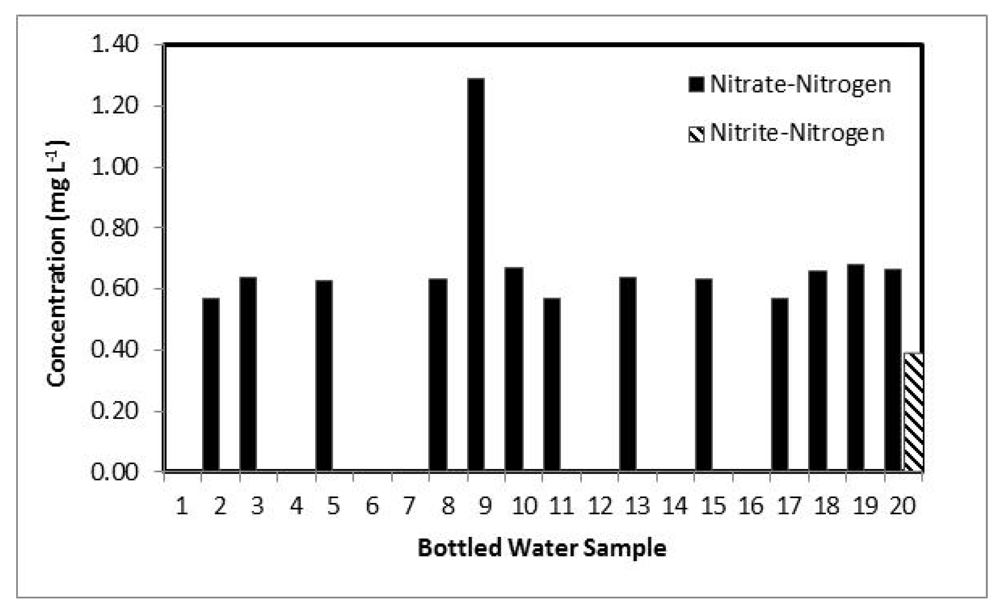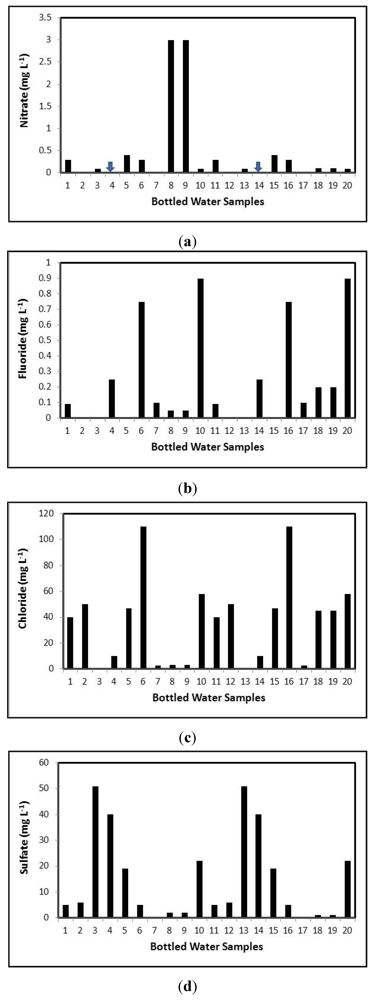Concentration of Selected Anions in Bottled Water in the United Arab Emirates
Abstract
:1. Introduction
2. Materials and Methods
2.1. Bottled Water Samples
| Country of Origin | Water Samples | Water Type a,b |
|---|---|---|
| UAE | 14 | Pure Natural Water |
| Pure Drinking Water | ||
| Pure Natural Mineral Water | ||
| Pure Distilled Water | ||
| Natural Spring Water | ||
| Saudi Arabia | 2 | Drinking Water |
| France | 2 | Natural Mineral Water from Alps |
| Lebanon | 2 | Natural Mineral Water |
2.2. Analysis of the Anions
3. Results and Discussion
| U.S. EPA | - | - | 1.00 | 10.00 |
| WHO | 3.00 | 50.00 | 0.90 | 11.00 |
| EC/DWD | 0.50 (0.10) | 50.00 | - | - |
| U.S. FDA/CFR | - | - | 1.00 | 10.00 |
| Water Sample | Nitrite-Nitrite | Nitrate-Nitrate | Nitrite-Nitrogen | Nitrate-Nitrogen |
| 1 | ND | ND | ND | ND |
| 2 | ND | 2.51 | ND | 0.57 |
| 3 | ND | 2.81 | ND | 0.64 |
| 4 | ND | ND | ND | ND |
| 5 | ND | 2.77 | ND | 0.63 |
| 6 | ND | ND | ND | ND |
| 7 | ND | ND | ND | ND |
| 8 | ND | 2.78 | ND | 0.63 |
| 9 | ND | 5.67 | ND | 1.29 |
| 10 | ND | 2.94 | ND | 0.67 |
| 11 | ND | 2.50 | ND | 0.57 |
| 12 | ND | ND | ND | ND |
| 13 | ND | 2.80 | ND | 0.64 |
| 14 | ND | ND | ND | ND |
| 15 | ND | 2.78 | ND | 0.63 |
| 16 | ND | ND | ND | ND |
| 17 | ND | 2.50 | ND | 0.57 |
| 18 | ND | 2.90 | ND | 0.66 |
| 19 | ND | 2.99 | ND | 0.68 |
| 20 | 1.29 | 2.92 | 0.39 | 0.66 |
| U.S. EPA (MCL)a | 4.00 | - | - | - | - |
| U.S. EPA (SMCL)a | 2.00 | 250.00 | - | - | 250.00 |
| WHO | 1.50 | - | - | - | - |
| EC/DWD | 1.50 | 250.00 | - | - | 250.00 |
| U.S. FDA/CFR | 1.70 | 250.00 | - | - | 250.00 |
| Water Sample | Fluoride | Chloride | Bromide | Phosphate | Sulfate |
| 1 | ND | 44.90 | 1.15 | ND | 4.18 |
| 2 | 0.12 | 39.00 | 1.21 | ND | 5.68 |
| 3 | ND | 19.04 | ND | ND | 50.20 |
| 4 | 0.20 | 5.56 | 1.31 | ND | 31.40 |
| 5 | ND | 56.30 | 1.16 | ND | 16.70 |
| 6 | 0.61 | 147.90 | 1.37 | ND | 4.38 |
| 7 | 0.20 | 5.53 | 1.31 | ND | 31.10 |
| 8 | ND | 55.50 | 1.15 | ND | 16.50 |
| 9 | ND | 2.47 | 1.36 | ND | 1.75 |
| 10 | 1.05 | 67.18 | 1.21 | 4.56 | 16.23 |
| 11 | 0.12 | 45.66 | 1.16 | ND | 3.65 |
| 12 | ND | 39.00 | 1.19 | ND | 5.27 |
| 13 | ND | 19.13 | ND | ND | 50.40 |
| 14 | 0.20 | 5.53 | 1.31 | ND | 31.30 |
| 15 | ND | 55.50 | 1.15 | ND | 16.30 |
| 16 | 0.64 | 145.70 | 1.45 | ND | 3.85 |
| 17 | 0.20 | 5.50 | 1.31 | ND | 31.00 |
| 18 | ND | 47.72 | ND | 4.58 | ND |
| 19 | ND | 46.50 | 1.05 | 4.55 | ND |
| 20 | 1.07 | 69.60 | 1.20 | 4.55 | 15.00 |
3.1. Bottled Water Container
3.2. Nitrate and Nitrite Anions

3.3. Other Anions

3.4. Bottled Water Labels
 (representing zero value) reported values for the anions.
(representing zero value) reported values for the anions.
 (representing zero value) reported values for the anions.
(representing zero value) reported values for the anions.
4. Conclusions
- In one sample, the nitrite level exceeded the permissible level set by the EC/DWD organization. Nitrite as well as nitrate may cause serious problems, and therefore, the nitrite level should be reduced so it does not pose any health risk, such as methemoglobinemia in infants.
- Some samples experienced high anion concentration levels, yet they did not exceed the set standard limits. Such results suggest that more attention should be given to the monitoring and treatment processes of the drinking water, so exceeding the permissible levels would not be experienced in the future, leading even to increased contamination if the infant formula or food used is also contaminated.
- Labeling of bottled water is an important tool that consumers may use to find information about the quality of the drinking water. Therefore, labeling information, in regard to which type of anions are reported, should be consistent from one brand to another. In addition, nitrite levels should be reported on the labels of the bottled water, since elevated levels of this anion could lead to serious health conditions, as is the case with nitrate and other anions.
Acknowledgements
References
- Saleh, M.A.; Ewane, E.; Jones, J.; Wilson, B.L. Chemical evaluation of commercial bottled drinking water from Egypt. J. Food Compos. Anal. 2001, 14, 127–152. [Google Scholar] [CrossRef]
- Ikem, A.; Odueyungbo, S.; Egiebor, N.O.; Nyavor, K. Chemical quality of bottled waters from three cities in eastern Alabama. Sci. Total Environ. 2002, 285, 165–175. [Google Scholar] [CrossRef]
- Mahajan, R.; Walia, T.; Lark, B.; Sumanjit. Analysis of physical and chemical parameters of bottled drinking water. Int. J. Environ. Health Res. 2006, 16, 89–98. [Google Scholar] [CrossRef]
- Guler, C. Evaluation of maximum contaminant levels in Turkish bottled drinking waters utilizing parameters reported on manufacturer’s labeling and government-issued production licenses. J. Food Compos. Anal. 2007, 20, 262–272. [Google Scholar] [CrossRef]
- Yekdeli Kermanshahi, K.; Tabaraki, R.; Karimi, H.; Nikorazm, M.; Abbasi, S. Classification of Iranian bottled waters as indicated by manufacturer’s labellings. Food Chem. 2010, 120, 1218–1223. [Google Scholar] [CrossRef]
- Cidu, R.; Frau, F.; Tore, P. Drinking water quality: Comparing inorganic components in bottled water and Italian tap water. J. Food Compos. Anal. 2011, 24, 184–193. [Google Scholar] [CrossRef]
- Birke, M.; Reimann, C.; Demetriades, A.; Rauch, U.; Lorenz, H.; Harazim, B.; Glatte, W. Determination of major and trace elements in European bottled mineral water: Analytical methods. J. Geochem. Explor. 2010, 107, 217–226. [Google Scholar] [CrossRef]
- Bityukova, L.; Petersell, V. Chemical composition of bottled mineral waters in Estonia. J. Geochem. Explor. 2010, 107, 238–244. [Google Scholar] [CrossRef]
- Smedley, P.L. A survey of the inorganic chemistry of bottled mineral waters from the British Isles. Appl. Geochem. 2010, 25, 1872–1888. [Google Scholar] [CrossRef] [Green Version]
- Gueler, C.; Alpaslan, M. Mineral content of 70 bottled water brands sold on the Turkish market: Assessment of their compliance with current regulations. J. Food Compos. Anal. 2009, 22, 728–737. [Google Scholar] [CrossRef]
- Pip, E. Survey of bottled drinking water available in Manitoba, Canada. Environ. Health Perspect. 2000, 108, 863–866. [Google Scholar] [CrossRef]
- Rosborg, I.; Nihlgard, B.; Gerhardsson, L.; Gernersson, M.-L.; Ohlin, R.; Olsson, T. Concentrations of inorganic elements in bottled waters on the Swedish market. Environ. Geochem. Health 2005, 27, 217–227. [Google Scholar] [CrossRef]
- Momani, K.A. Chemical assessment of bottled drinking waters by IC, GC, and ICP-MS. Instrum. Sci. Technol. 2006, 34, 587–605. [Google Scholar] [CrossRef]
- Cicchella, D.; Albanese, S.; de Vivo, B.; Dinelli, E.; Giaccio, L.; Lima, A.; Valera, P. Trace elements and ions in Italian bottled mineral waters: Identification of anomalous values and human health related effects. J. Geochem. Explor. 2010, 107, 336–349. [Google Scholar] [CrossRef]
- L’Hirondel, J.; L’Hirondel, J.-L. Nitrate and Man: Toxic, Harmless or Beneficial? CABI Publishing: New York, NY, USA, 2002. [Google Scholar]
- World Health Organization (WHO). Guidelines for Drinking-Water Quality; WHO Press: Geneva, Switzerland, 2011, 4th ed. Available online: http://www.who.int/ (accessed on 9 November 2011). ISBN: 978 92 4 1548151.
- Mesa, J.M.C.; Armendariz, C.R.; de la Torre, A.H. Nitrate intake from drinking water on Tenerife island (Spain). Sci. Total Environ. 2003, 302, 85–92. [Google Scholar] [CrossRef]
- Gupta, S.K.; Gupta, R.C.; Gupta, A.B.; Seth, A.K.; Bassin, J.K.; Gupta, A.; Sharma, M.L. Recurrent diarrhea in children living in areas with high levels of nitrate in drinking water. Arch. Environ. Occup. Health 2001, 56, 369–373. [Google Scholar]
- United States Environmental Protection Agency (U.S. EPA). Drinking Water Contaminants: National Primary and Secondary Drinking Water Regulations; U.S. EPA: Washington, DC, USA, 2009. Available online: http://water.epa.gov (accessed on 9 November 2011). EPA 816-F-09-004.
- United States Food and Drug Administration (U.S. FDA). Regulations of Bottled Water; U.S. FDA: Silver Spring, MD, USA, 2009. Available online: http://www.fda.gov (accessed on 9 November 2011).
- United States Code of Federal Regulations (CFR), Title 21: Food and Drugs, 21 CFR 165.110; 60 FR 57124. 2011. Available online: http://ecfr.gpoaccess.gov (accessed on 9 November 2011).
- European Commission (EC). Council directive 98/83/EC of 3 November 1998, on the quality of water intended for human consumption. Off. J. Eur. Communities. 1998, L330, pp. 32–54. Available online: http://eur-lex.europa.eu/ (accessed on 9 November 2011).
- Nsanze, H.; Babarinde, Z.; Al Kohaly, H. Microbiological quality of bottled drinking water in the UAE and the effect of storage at different temperatures. Environ. Int. 1999, 25, 53–57. [Google Scholar] [CrossRef]
- Brencic, M.; Ferjan, T.; Gosar, M. Geochemical survey of Slovenian bottled waters. J. Geochem. Explor. 2010, 107, 400–409. [Google Scholar] [CrossRef]
- Adam, J.W. Health aspects of nitrate in drinking-water and possible means of denitrification (Literature review). Water SA 1980, 6, 79. [Google Scholar]
- Agency for Toxic Substances and Disease Registry (ATSDR), Case Studies in Environmental Medicine (CSEM): Nitrate/Nitrite Toxicity; U.S. Department of Health and Human Services: Atlanta, GA, USA; pp. 2007–2010.
- Egboka, B.C. Nitrate contamination of shallow groundwaters in Ontario, Canada. Sci. Total Environ. 1984, 35, 53–70. [Google Scholar] [CrossRef]
- George, S.; Rasmussen, W.; Ofitserova, M.; Pickering, M. Nitrite and Nitrate Analysis: Simultaneous Determination of Nitrite and Nitrate in Baby Foods; Pickering Laboratories, Inc.: Mountain View, CA, USA, 2006. [Google Scholar]
- George, S.; Ofitserova, M.; Pickering, M. Nitrite and Nitrate Analysis: Simultaneous Determination of Residual Nitrite and Nitrate in Processed Meats; Pickering Laboratories, Inc.: Mountain View, CA, USA, 2007. [Google Scholar]
- Merino, L.; Edberg, U.; Fuchs, G.; Aman, P. Liquid chromatographic determination of residual nitrite/nitrate in foods: NMKL collaborative study. J. AOAC Int. 2007, 83, 365–376. [Google Scholar]
- World Health Organization (WHO). Analytical and Water Treatment Methods for Health-Based Guideline Values; Report on a WHO consultation, Medmenham, UK, 27–29 January; WHO Regional Office for Europe: Copenhagen, Denmark, 1992.
- Santamaria, P. Nitrate in vegetables: Toxicity, content, intake and EC regulation. J. Sci. Food Agric. 2006, 86, 10–17. [Google Scholar] [CrossRef]
© 2012 by the authors; licensee MDPI, Basel, Switzerland. This article is an open-access article distributed under the terms and conditions of the Creative Commons Attribution license (http://creativecommons.org/licenses/by/3.0/).
Share and Cite
Abouleish, M.Y.Z. Concentration of Selected Anions in Bottled Water in the United Arab Emirates. Water 2012, 4, 496-509. https://doi.org/10.3390/w4020496
Abouleish MYZ. Concentration of Selected Anions in Bottled Water in the United Arab Emirates. Water. 2012; 4(2):496-509. https://doi.org/10.3390/w4020496
Chicago/Turabian StyleAbouleish, Mohamed Yehia Z. 2012. "Concentration of Selected Anions in Bottled Water in the United Arab Emirates" Water 4, no. 2: 496-509. https://doi.org/10.3390/w4020496




